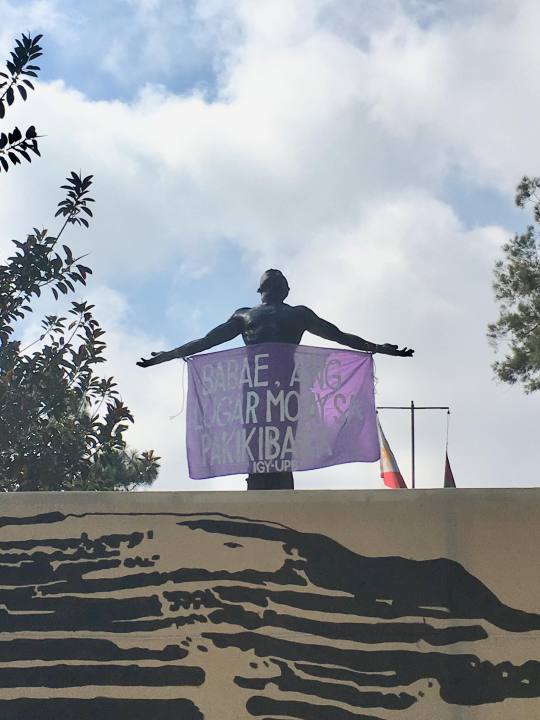There is the apparent and continuous rise and trend of viral dances, acting and performance videos influencing people from all over the world being done by all races and culture. By drawing inspiration from this, we aim to become a progressive voice for various topics and issues worldwide. Tik-TALK is an avenue to discuss and provide critical views on what is going on in the different forms of mass media, its effects, influences and impact to the busy society. We will be providing insights and overviews in a fun and engaging way for the audience of this blog. Stay tuned for updates here in Tik-TALK!
Don't wanna be here? Send us removal request.
Text
Vlog Entry on Identity
https://drive.google.com/file/d/17gSvitKuMxdpwlZztihJGhuBpFoGg_V2/view?usp=sharing
Submitted By: Pelaco, Allonah Therese B.
0 notes
Text
Vlog on Communication and Self-Identity
File uploaded on Google Drive of Google Classroom Comm10-P
https://drive.google.com/file/u/1/d/1Mr66EYsGSanHNh4q7WYPaZx7foQ7YxoT/view?usp=drive_open
Submitted by: Cabrera, Lara Michelle B.
0 notes
Text
SHE-Who-Must-Be-Named

In commemoration of the Women’s History month that is annually celebrated every March, the University of the Philippines Baguio headed by the Student Council and other progressive groups also took part in the said occasion. The various activities and educational discussions held not only celebrates women in general but especially gives recognition and voice to those women that have been exploited, discriminated, and deemed inferior just because of their gender. This banner is a call for every women despite their age, class and race to join in on the fight against patriarchy. Women’s Right Movement has been in place since mid-19th century yet even now the fight has not yet ended. Before this historic movement, women were not even allowed to vote and fulfill highly specialized roles in society because “a woman’s place is in the kitchen” and this banner is a direct resistance to that outdated statement. Yes, women now have the right to vote and even run for a position in the government yet why are women still out on the streets screaming for justice at the top of their lungs? That’s because several injustices are still experienced by our women in today’s society. Sexism and stereotype, unequal pay, maltreatment at the workplace, domestic and sexual violence — these are just few of the oppressive acts done to our women in their everyday lives.
There is this advocacy for the rights of our women on the basis of the social equity of the sexes which is more prominently known as Feminism. When people, not just women, refer to themselves as feminists with the idea in mind of fighting the patriarchal society, majority of people have the misconception that being a feminist is equal to being a misandrist or someone who is strongly prejudiced against men. Since many people have started referring to themselves as feminists, some people fear that this would lead to the oppression of men, but that is not so. Both these are not the case because feminism aims for the equality of both sexes and is not about women being above men. Misandry is not what the banner and the fight for equal rights for women are all about.
Because this banner also represents activism in general, for someone not fully aware of country's current problems and not part of the UP community, they might be shocked and perhaps startled by the banner draped across the oblation. Especially for people who do not support protests and activism, they might assume that all students take part in walk-outs and promote being "against the government" as others would say. Others might also assume that the students prioritize initiating protests rather than studying. Some people also think that protests and rallies are a waste of time and they would even say that the students are wasting the taxes they pay for our tuition fees as state universities. People who are not aware that we are free to choose our beliefs and actions here in UP immediately assume that we are all going against the government. But in reality, it is not the entire UP community who join the walk-outs and student activists do not protest for merely for themselves but for the rights of the Filipinos, our women in this case, that the government and even common people may be violating or abusing.
0 notes
Text
It’s Not Just Black and Yellow

Ribbons are prominently used as a representation of awareness depending on the color. Most common colors of ribbons each with various associated meanings are the colors red, pink, blue, green and yellow among others. With this symbol of awareness, the yellow ribbon represents a lot of things across different countries or cultures.
A bright yellow ribbon tied around a tree may seem random to a bypasser who will see it as they pass by Sunshine Park in Baguio City. It is conveniently placed at a location that many people can easily spot and notice. While foreigners may not mind seeing this or may not do a double take, majority of Filipinos, by merely seeing a yellow ribbon in public, would instantly relate this sign or symbol to a historical event that shaped our nation. It calls one’s attention and presents itself as a symbol of a recently commemorated event last February 25 in Philippine history, the EDSA Revolution. It is immediately symbolic to Filipinos because we are aware that it means something, be it positive or negative based on a person’s perspective. The yellow ribbon was an established symbol in our history that reminded everyone of the event that took place which is the dictatorship of Former President Marcos. At once, a yellow ribbon reminds Filipinos of the Aquinos and the Liberal Party, who wore a small yellow ribbon on their chests to signify freedom and democracy back then.
Perhaps unpopular to most Filipinos is that even before the EDSA Revolution, a song by Tony Orlando entitled “Tie A Yellow Ribbon ‘Round the Ole Oak Tree” was already released back in February 19, 1973. The song talks about a woman who waits for her soldier lover, and this lover of hers told her to tie a yellow ribbon around the oak tree to show that she is waiting for him to return. Only few are aware of this despite the title being actually seen usually when you press number 7 on most videoke machines. This may be known amongst the elderly but not to the younger generations.
What we commonly associate with this yellow ribbon is the political aspect of being biased to the Aquino administration or Liberal Party especially during the presidency of both the late Cory Aquino and her son Benigno Aquino III. A lot of people believe that a yellow ribbon is associated to being biased to the Liberal Party and that such people are referred to as “dilawan”. They are often connoted to be against the current administration and until now people debate about this team with their positive and negative views. It seems as if it’s just either one or the other: a person is either pro-Marcos or a dilawan. When in truth, not all of those who support the advocacies of the people under the Liberal Party are trying to go against who is currently in position. They are simply overgeneralized to be blind supporters of the Aquinos and the Liberal Party because this misconception has been drilled to the minds of some Filipinos.
In Western perspective, the Americans used it as a sign of support for their troops who were sent to the Middle East during the Gulf War. Another account is according to Gerald E. Parsons who stated that the first significant use of the yellow ribbon was during the end of the Iran hostage crisis. But the underlying concept from both these accounts is that the yellow ribbon represents the remembrance or the memory of those loved ones that are in places far away. Tying a yellow ribbon shows the devotion of those that are left behind for a long time yet still faithful to the promise of their loved ones’ return. In the Philippine setting however, having been predominantly used as a symbol for the anti-Marcos regime, this sign has been collectively known to symbolize or represent protest or defiance in the face of injustice and oppression.
0 notes
Text
ENTRY 01.

This meme presents us a reality among us Filipinos that shows how much individuals nowadays value their “social status” and reputation in the society.

Ukay-ukay is now a trend specifically among the youth especially after many YouTube vloggers post videos of their “ukay-ukay haul”. This influenced a lot of people to view Ukay-ukay as an avenue to buy cheap but fashionable clothes.

Be it by accident or carelessness, an iPhone with a cracked screen denotes how people still stick with their pricey Apple phones despite it being damaged.

Popular and internationally branded coffee shops with drinks not less than P100 is continuously patronized for different reasons. It may be the ambience, quality, packaging, taste, or just because it’s famous.

Lastly, and sadly, a penniless wallet after all these purchases for necessity and leisure.
The entire meme presents a somehow “pretentious” identity that people might relate to. There are a lot of people who are really conscious of their social status and even with their virtual identity through the stuff they share online. Friends online might see someone as well-off based on the photos of expensive items and fashion people post. However in reality that person might not be financially stable but simply want to project that he or she is able to afford such branded items. This is one of the negative aspect of social media and the power that influencers or famous people may have drilled into our minds. We want to look good in the eyes of our peers and even anyone who we interact with that we start to build and liken our image to the elite people in the society. In truth, all of us are not able to afford the same lifestyle and it’s not practical to spend so much just to fit in. We have to accept we are not all from the same social class and we should enjoy the simple pleasures and luxuries of life without the risk of going broke.
[meme found in: https://facebook.com/711philippines/posts/10159556595918228]
0 notes
